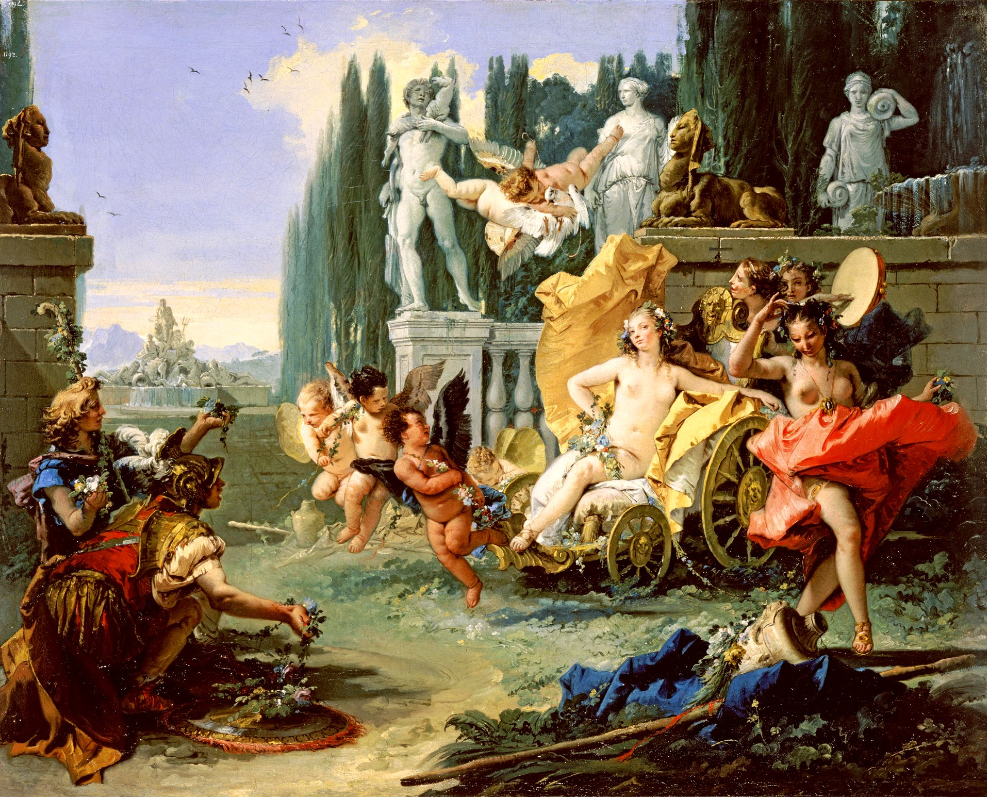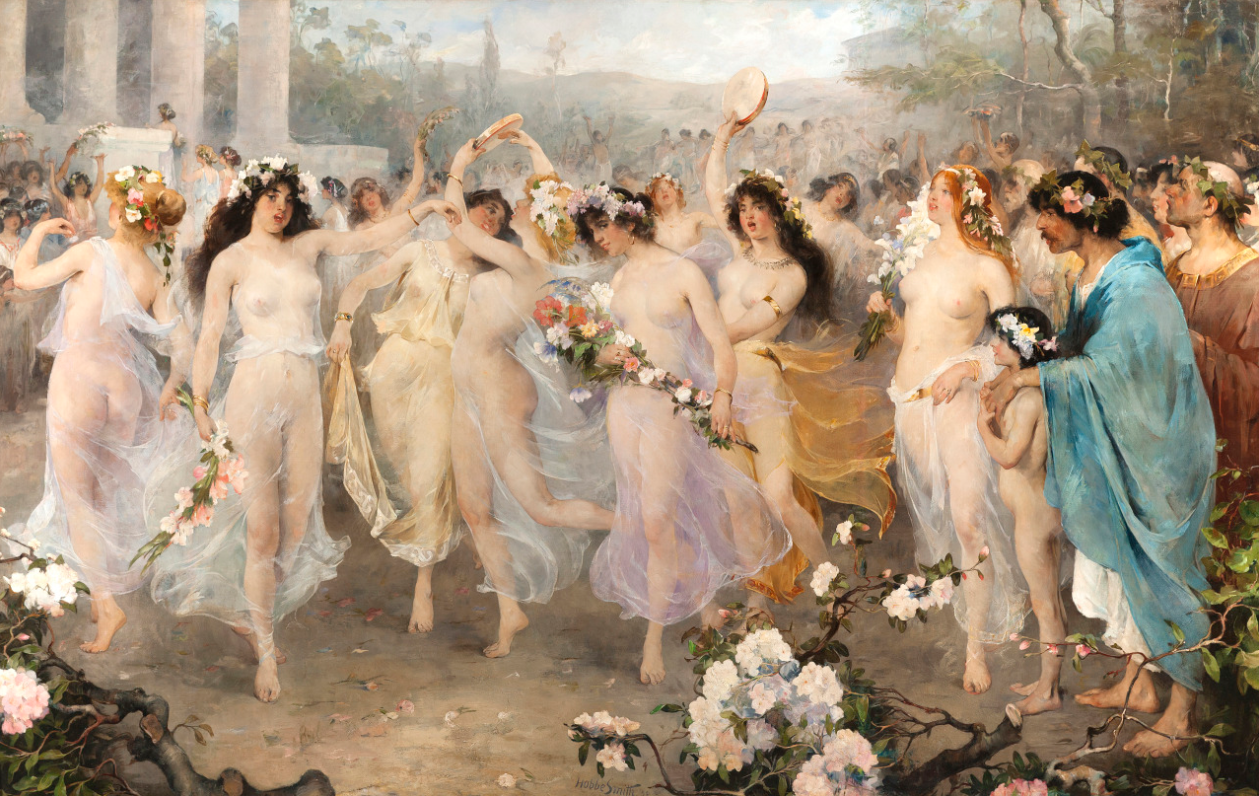Flora: The People’s Goddess
The Empire of Flora; Giovanni Battista Tiepolo (1696–1770)
As the cold winter melts away and the weather warms, the ancient Romans celebrated their most well-known springtime festival. The Floralia traditionally began on April 28th, lasted six days, and celebrated the goddess Flora. She is a uniquely Roman goddess with no Greek counterpart and is traditionally known as the goddess of Spring.
Despite being somewhat ignored by Roman authors and classicists alike – at least in comparison to other deities – Flora held a very important position in the Roman pantheon as well as the cultural spheres of Rome. She was one of the only goddesses to receive her own flamen (or priesthood). Her domain didn’t merely extend to florals and springtime; she was also a protectress of the plebeians as well as sex laborers.
Flora’s earliest – and most comprehensive – appearance in Roman literature is within the pages of Ovid’s Fasti. This 1st-century CE work details the progression of the Roman calendar, including information about various holidays and festivals. In her narrative, Flora recalls her mythological beginnings: once she was a beautiful nymph named Chloris who caught the attention of the powerful Western wind, Zephyrus. In a story that rings similar to that of Pluto and Prosperina, Zephyrus kidnaps Chloris, rapes her, and then makes her his bride. As wife to Zephyrus, Chloris is transformed into a goddess and takes on the name of Flora.
Ovid doesn’t only recount the mythological background of the Floralia, however; he also includes a historical anecdote regarding the founding of the festival. When asked about the origin of the Floralia, the goddess explains that her games were originally funded on the back of a victory for the common people. The story she tells refers to an actual historical event that took place in the 3rd century BCE.
During that period, wealthy Roman landowners had begun to encroach upon public land, allowing their cattle to graze illegally and sequestering some of it for themselves. The plebeian aediles were eventually able to punish and fine them for their transgressions, and they donated some of the money they won to the creation of Flora’s festival. Her festival every year celebrates not only the coming of spring but the strength and resilience of the plebeians against overwhelming odds.
One of the most infamous parts of Flora’s festival was the presence and visibility of sex laborers within the festivities. Sex laborers were well-known participants in the Floralia, performing dances and even enacting fake gladiatorial combat in the nude (according to Juvenal, but it’s more likely that they were mime shows). It was a time when social boundaries dissolved, and sex laborers – who were traditionally ignored in early Imperial Roman society – were given the spotlight. Ovid himself points out that the inclusion of sex laborers within the Floralia is because Flora is “...neither one of the glum ones or a snob/ she wants her rites open to the plebs” (351-52). Flora’s protection of the sex laborers of Rome is directly tied to her position as a goddess of the people.
One of Flora’s greatest acts of representing the common people is seen in her standing up to Emperor Augustus – metaphorically speaking, anyway. Flora has plenty of reasons to be angry with Augustus. When her temple was destroyed in 3 CE, it wasn’t repaired until 17 CE under the emperor Tiberius. Note that the temple of Magna Mater was destroyed during the same year, and Augustus was rather speedy about restoring it to its former glory. Augustus had a habit of leaving the cult centers of traditionally plebeian cults in disrepair – not only Flora but also Liber and Libera.
It is seemingly no coincidence that Augustus seemed to disregard Flora; she is, after all, a goddess well beloved by the plebs and who encourages debauchery and fun. However, Flora has her revenge through Ovid’s clever structuring of his Fasti – specifically, he decides to move Flora’s festival from the end of Book 4 (April holidays) to Book 5 (May holidays). This is to “make room” to describe the dedication of a temple to Vesta.
Hobbe Smith (1862 - 1942) - Floralia
By having Flora concede her place in the narrative, Ovid is deliberately pitting the two goddesses against each other. Flora is therefore framed as a generous goddess, benevolently allowing Vesta to take her place. While Vesta, one of Augustus’ favored goddesses, looks to be somewhat of a nag and a killjoy for forcing a fun goddess like Flora to move. It is no coincidence that Ovid chose Flora, the protectress of the plebs, to stand up against Augustus and his patrician patroness.
It is also worth noting that within his narrative, Ovid dedicates an overwhelming amount of space to discussion of the Floralia. Flora is given several hundred lines, and many of them feature the goddess herself leading the discussion, instead of Ovid. In comparison, Vesta and her festival are given only the briefest description. Ovid makes no secret of favoring Flora and her plebeian ways over Vesta.
Ovid’s portrayal of Flora is incredibly positive, which differs somewhat from how her festival is depicted by other Roman authors of the time (when they were depicted – as mentioned earlier, she was often ignored by Augustan-era writers). While Ovid praises her festival and rites, and even excuses their debauched nature, authors like Martial and Juvenal tend to disapprove of the lewder aspects of the Floralia.
Ovid’s Flora, which is the oldest and best-known version of her to exist, is a powerful and important goddess. She can bring Rome to ruin with merely a thought. It was she who provided Juno with the means to birth Mars, the father of Rome. In Ovid’s narrative, she is pitted against Vesta, Venus, and Ceres – all heavy hitters within the Roman pantheon.
And this powerful goddess doesn’t belong to the upper classes; instead, she belongs to the plebeians, the sex laborers, and the common people.
Further Reading
Chiu, Angeline. Ovid’s Women of the Year: Narratives of Roman Identity in the Fasti. University of Michigan Press, 2016.
Fabbri, Lorenzo. Mater Florum. Flora e il suo culto a Roma. Casa Editrice Leo S. Olschki, 2019.
Fantham, Elaine. “Ceres, Liber and Flora: Georgic and Anti-Georgic Elements in Ovid’s Fasti: I The ‘Georgics’ as Model.” Proceedings of the Cambridge Philological Society, no. 38 (1992): 39–56.
Newlands, C. E. (1995). Playing with Time: Ovid and the “Fasti” (Vol. 55). Cornell University Press.
About the author
Regina Nagan is a graduate of Mount Holyoke College and Brandeis University. Her academic interests include women in myth, classical reception, and war elephants. When she isn't writing, she works in the arts and museum sector of Indianapolis, Indiana.



